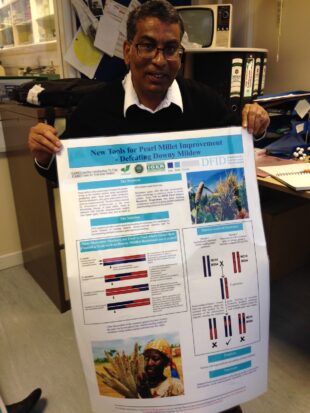Dr Rattan Yadav, Research Leader at Aberystwyth University, has been working to develop and use genetic variations of pearl millet for 19 years. In this Agri-Tech Catalyst project, his work is taking a new direction to develop a grain that is beneficial to people suffering from type-2 diabetes. Here, he tells us more about the project, its potential benefits and progress so far.
For those who aren’t familiar with it, what is pearl millet?
Pearl millet is a grain that grows primarily in hot, dry climates, largely in parts of India and Africa. It is used to make soup, porridge, flat breads, and other foods. It grows in areas where other crops cannot – where air temperatures can exceed 55 degrees centigrade. It has high levels of iron and zinc, and other health benefits, so it is a staple food for many people and demand for it is increasing.

Tell us about this project, what are you seeking to achieve?
We are developing a variety of pearl millet that is beneficial for people with type-2 diabetes, which will ultimately be developed into new food products for them to consume. Some pearl millet varieties have more of the ‘ingredient’ that is beneficial for those with type-2 diabetes than others. So we’re looking at the genetics of hundreds of pearl millet varieties to identify their genotypes and then breed a grain with the best properties for helping type-2 diabetics, but can still grow in difficult conditions and produce sufficient yields.
Why pearl millet?
This grain has characteristics that can help reduce the occurrence of type-2 diabetes or potentially correct it in people that already suffer from the condition. Some of the starch within it is released very slowly in the stomach, so you don’t have a big sugar spike, while other starch isn’t digested, which helps because bacteria eat it so it is not absorbed.
What have you done so far and what’s next?
We have collected varieties of pearl millet over the last 20 years and have made a sample to represent the 10,000 lines in existence – a collection of 400 lines. We will sequence the whole genome of each line, then phenotype them. We’ll then examine the data – looking for the characteristics to identify the part of the gene we’re interested in, and then breed them to get the type of plant we want. Using the gene sequence makes this a lot quicker than breeding by simply looking at the crop. Ultimately farmers will be able to buy the new seeds and then grow pearl millet for industry to develop products from.

How long will it take to develop new products?
Once we know the genes, development takes at least 5 years to get products ready to eat – that involves producing the crop and then creating the products. Developing products takes time, as you need to look at the processes of production and how that might affect its nutritional value. Our industrial partners will look at what kind of products might be wanted, depending on the target market, such as biscuits, breads and breakfast cereals. But some things may not work – for example the high oven temperatures may alter the ingredients, we will have to experiment and see. Bread may be easier though as it may be possible to modify existing bread with pearl millet (which will also make it taste even better!).
What benefits does this project offer and how it is innovative?
Obviously there are benefits to consumers through the products that will be developed, helping those suffering from type-2 diabetes. We are also successfully increasing the amount of zinc and iron in pearl millet, so it has more nutritional value for all consumers. But farmers will also benefit, as a higher demand for this crop could significantly increase their livelihoods, and it could result in an increase in grain prices. Demand for crops like this will only increase in the face of climate change. This is also the first systematic study to look at varieties of pearl millet and how much we can combine these, so it’s an exciting opportunity for us.
Where did you hear about the Agri-Tech Catalyst?
We’re always on the lookout for funding opportunities! We have worked with the Department for International Development over the years where our work has been focussed on developing strains of pearl millet that are better at surviving drought and downy mildew disease conditions, and we’ve had a lot of success in this area.
How has this Catalyst funding helped support the project?
The Agri-Tech Catalyst funding enables people to think bigger! Before, our work was primarily focussed on developing pearl millet with a greater resistance to drought. But the Catalyst gave us a reason to take a more economic view. We’re transferring the science we already had and applying it to a new issue – the increasing number of people suffering from type-2 diabetes, particularly in India, where it stands at 40 million currently and is expected to reach 70 million by 2025. We couldn’t have done this project without Catalyst funding, and it’s great to be able to bring different areas together for a new purpose.
How did you find the application process for the Catalyst and would you recommend it?
The application process was pretty straightforward, so I would certainly recommend it!
Find out more about the Agri-Tech Catalyst and how to apply for funding on the Innovate UK website.

Recent Comments